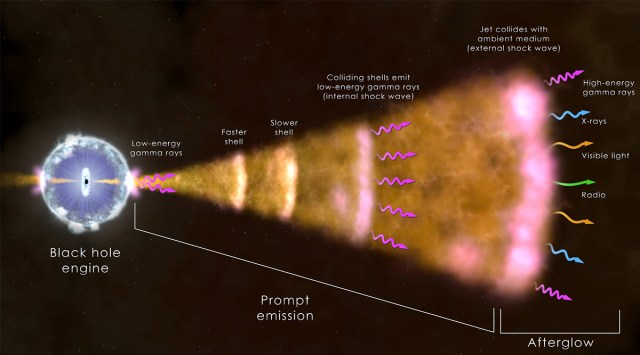Astronomers study ‘monstrous 1 in 10,000 years’ space explosion
Astronomers are studying an unusually long-lasting and powerful signal from a gamma-ray burst, the most powerful class of explosion in the universe, that swept through our planet last year.
 This illustration depicts how such gamma-ray bursts are typically formed. (Credit: NASA's Goddard Space Flight Center)
This illustration depicts how such gamma-ray bursts are typically formed. (Credit: NASA's Goddard Space Flight Center) An unusually bright and long-lasting pulse of radiation from a “space explosion” swept over our planet on October 9, 2022. It was caused by a “gamma-ray burst” (GRB), the most powerful class of explosions in the universe.
According to NASA, the GRB triggered detectors on various spacecraft as well as observatories around the world. Astronomers have looked through all this data and can now characterise how bright it was to help better understand its scientific impact.
“It is just an absolutely monstrous burst. It is extremely extraordinary; we’ve never seen anything remotely close to it,” Eric Burns during a press conference at the 20th meeting of the American Astronomical Society’s High Energy Astrophysics Division in Hawaii, according to Space.com.
Burns is an assistant professor of physics and astronomy at Louisana State University. According to him, GRB 221009A was likely the brightest burst at X-ray and gamma-ray energies to occur since human civilization began.
This burst was so exceptionally bright that many gamma-ray instruments in space were effectively blinded, meaning they could not record the real intensity of the emission. But scientists were able to reconstruct this information using data from NASA’s Fermi Gamma-ray Space Telescope.
They found that the signal from GRB 221009A had been travelling for about 1.9 billion years before it reached our planet. According to NASA, astronomers believe that these bursts represent the birth cries of black holes that are formed when the cores of massive stars collapse under their own weight.
When such black holes begin quickly ingesting the matter around them, they blast out jets in opposite directions. These jets contain particles that are accelerated to near the speed of light. When these jets pierce through the star, X-rays and gamma rays stream into space.
Usually, with this type of GRB, astronomers expect to find a supernova a few weeks later but that has proven elusive so far. NASA proposes that one reason could be because the GBR came from a part of the sky which is just a few degrees above the plane of our own galaxy. There, thick clouds of gas and dust can dim the incoming light.







